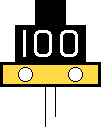|
|
|
|
|
|
|
|
|
From November 1989, fixed TSR indicators were available for use at either end of Box Tunnel (Western Region). On each line, a warning indicator, a speed indicator and a termination indicator were erected, all of which were normally blank. On occasions when a TSR of 100 mph was planned to be imposed for the protection of staff working in the tunnel, the indicators were switched on, causing each one to show an illuminated fibre-optic display. When the TSR was imposed, both the warning indicator [14.50] and the speed indicator [14.51] exhibited an illuminated number "100" in white, and the termination indicator displayed an illuminated white "T" on a black background (see [14.11]). The warning indicator and the speed indicator were both capable of displaying a spate indication when required [14.52 & 14.53]. AWS equipment was installed on approach to each warning indicator, and this was operational only when the indicators were switched on.
 |
 |
|
[14.50] Warning Indication.
Area: Box Tunnel Usage: Low Status: Historical |
[14.51] Speed Indication.
Area: Box Tunnel Usage: Low Status: Historical |
|---|---|
 |
 |
|
[14.52] Warning Indication with Spate Indication.
Area: Box Tunnel Usage: Low Status: Historical |
[14.53] Spate Indication in lieu of speed indication.
Area: Box Tunnel Usage: Low Status: Historical |
|
Both lines over the Forth Bridge (Scottish Region) are signalled bi-directionally to allow all traffic to be worked over one line, in both directions, while the other line is out of use and under possession for engineering work. Following a review of safety arrangements on the bridge, revised signing arrangements for permanent and temporary speed restrictions were introduced in July 1993. Wrong-direction movements were subject to a 20 mph permanent speed restriction. For all pre-planned work, a temporary speed restriction of 20 mph was imposed for right-direction movements, but no warning board or AWS equipment was provided. The speed indicator comprised a blue circular board [14.55], which replaced the permanent speed restriction sign normally exhibited on the approach to the bridge. The termination indicator had a white "T" on a blue background (see [14.27]). Drivers could accelerate as soon as the front of the train had passed the termination indicator. If the work was unplanned or the restriction was more severe than 20 mph, then standard TSR signage including warning boards and AWS was provided. |
|
|
From 1996, directional indicators were being used at speed indicators where the TSR applies through a divergence immediately beyond [14.56], in addition to their original usage at TSR warning boards (see [14.41]). |
|
Reflectorised boards for temporary speed restrictions were introduced from 1996, having been on trial since 1994. While this change did not alter the appearance of most of the boards, the new warning board was given two white spots [14.57 - 14.60] instead of flashing white lights. A revised design of repeating warning board, with a yellow background to the letter "R" [14.61], was introduced at the same time.
 |
 |
 |
|
[14.57] Reflectorised Warning Board.
Area: All Areas Usage: High Status: Current |
[14.58] Reflectorised Warning Board for a Differential TSR.

Area: All Areas Usage: High Status: Current |
[14.59] Reflectorised Warning Board with Directional Indication (e.g. applicable to TSR on right-hand divergence).
Area: All Areas Usage: High Status: Current |
|---|
 |
 |
|
[14.60] Reflectorised Warning Board with Spate Indication.
Area: All Areas Usage: High Status: Current |
[14.61] Repeating Warning Board.

Area: All Areas Usage: High Status: Historical |
|---|
|
A track condition that presents itself as a series of regular dips in the vertical alignment is referred to as 'cyclic top'. It has the potential to cause a derailment unless a TSR is imposed. Commencing in February 1998, a trial of signage indicating a cyclic top restriction [14.62] was carried out between Tonbridge and Redhill. |
|
|
A reflectorised form of emergency indicator was on trial on the Great Eastern Main Line and the London, Tilbury & Southend line (East Anglia Zone) between October 1999 and March 2000. This experimental indicator was of similar size and appearance to a standard emergency indicator (see [14.48]), but no lights were fitted [14.63]. For these trials, the experimental indicator was placed close to the standard emergency indicator on the approach to an ESR. Following comments received from traincrews, a modified reflectorised indicator incorporating two flashing white lights was on trial between April 2000 and September 2000 on the same routes. For a period thereafter, the modified reflectorised indicators were provided in place of the standard emergency indicators on approach to some ESRs. |
|
On 15 January 1999, a passenger train was derailed near Crosby Garrett Tunnel on the Settle & Carlisle Line and struck by a freight train heading south on the opposite line. Debris from a landslip had caused the derailment. A derailment and collision had occurred under similar circumstances on 31 January 1995 at Ais Gill on the same route, and in that incident the guard of the first train was killed by the collision.
Following an investigation into the Crosby Garrett accident, the Health and Safety Executive issued an Improvement Notice on Railtrack, compelling it to take steps to reduce the likelihood of derailment of trains caused by landslips. The resulting arrangements put in place late in 1999 required trains to travel at a reduced speed (20 mph) during severe weather conditions at particular sites where cuttings or embankments were considered to be vulnerable to landslip. Rain gauges were installed at the sites concerned to enable a decision to be made as to whether a caution should be imposed.
Signs were permanently installed on the approach, beginning and end of each caution area, each showing "C20" on a white background surrounded by a blue border [14.64 - 14.66]. The warning board on the approach to each site additionally had two white spots on a blue background at the bottom [14.64], while the sign at the end of a caution area had a red diagonal cross superimposed [14.66]. Normally, these boards could be disregarded. On occasions when a caution was to be imposed, the driver of each train would be stopped and verbally instructed to obey the caution boards at all sites between that signal box and the next box. Additionally, the signalman would not allow another train into the affected area until the first train had passed clear.
 |
 |
 |
|
[14.64] Caution Area Ahead Warning Board.
Area: Settle & Carlisle Line Usage: Medium Status: Historical |
[14.65] Commencement of Caution Area Board.
Area: Settle & Carlisle Line Usage: Medium Status: Historical |
[14.66] End of Caution Area Board.
Area: Settle & Carlisle Line Usage: Medium Status: Historical |
|---|
In August 2000, lettered boards [14.67 - 14.69] were provided on every caution board to enable each site to be individually identified. The thirteen sites were identified by the letters A to H and J to N. When a caution was to be imposed, the signalman at either Hellifield or Low House Crossing would issue the driver with a form listing at which sites the caution boards were to be obeyed.
 |
 |
 |
|
[14.67] Caution Area Ahead Warning Board (e.g. site 'A').
Area: Settle & Carlisle Line Usage: Medium Status: Historical |
[14.68] Commencement of Caution Area Board (e.g. site 'C').
Area: Settle & Carlisle Line Usage: Medium Status: Historical |
[14.69] End of Caution Area Board (e.g. site 'N').
Area: Settle & Carlisle Line Usage: Medium Status: Historical |
|---|
Following the completion of earth stabilisation works, most of the caution boards were removed in 2005.
In connection with the joint running of heavy rail trains and Tyne & Wear Metro units between Pelaw and Sunderland from January 2002 (see Section 13), temporary speed restriction signs are required to show speeds in kilometres per hour as well as in miles per hour. The "kmh" speed is shown on a hexagonal board below the miles per hour speed in both the warning board [14.70] and speed indicator [14.71]. Because of the different conditions applicable only to Metro units, the "kmh" speed is not usually the direct metric equivalent of the speed shown in miles per hour.
 |
 |
|
[14.70] Warning Board with metric sign applicable to Metro units.
Area: Pelaw - Sunderland (subsequently also Ashford International) Usage: High Status: Current |
[14.71] Speed Indicator with metric sign applicable to Metro units.
Area: Pelaw - Sunderland (subsequently also Ashford International) Usage: High Status: Current |
|---|
|
|
|